
Vamos Rent-A-Car wants our customers to enjoy their hard-earned time off and not have to worry about Costa Rica's limited infrastructure, so we’ll help take the hassle out of your vacation. Let the fun begin!
Most of the main roads in Costa Rica are paved and are in good to fair condition. However, many side roads are in desperate need of repair. Over the last eight years, great strides have been made to repair roads, but potholes and other road damage still persists. Therefore, we suggest renting an all-wheel drive vehicle (4x4) to maximize your comfort with higher clearance.
Being aware of the season in which you’ll be visiting will help you prepare as well; whether it’s Green (Mid-April to October) or High (November to Mid-April) Season. View our Traffic Alerts for specific seasonal information.
Please keep in mind that new shocks and tires are not going to smooth out the ruts and hard-packed dirt roads that you may encounter. This is a part of Costa Rica; you may have to "rough it" a bit. Smile, roll with it and live to tell the tale of the car-sized pothole…they’re still out there…somewhere.
Once out of the capital, unless you’re traveling at the height of High Season, the roads are fairly quiet and you’re more likely to pause for cows crossing the road than you are for a rush hour crush. Here are a few pointers that may help you to negotiate the roads:
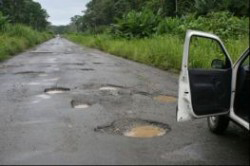
“Challenges in Costa Rica” © VamosRAC
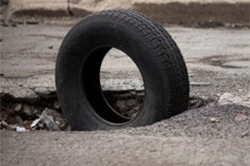
"Marked Pothole" photo © VamosRAC
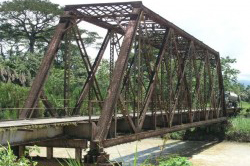
"One-Lane Bridge" photo © VamosRAC
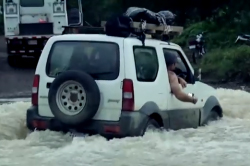
"River Crossing" photo © YouTube
Wondering about other road users? Generally, the rule is to drive defensively in Costa Rica. Although "Ticos" are known as friendly and relaxed people, there tends to be a transformation behind the wheel! Clues for deciphering Tico driving are below, but be warned. You’ll have to take your best guess at what they’re trying to tell you.
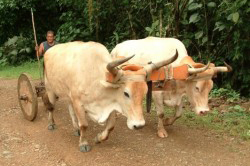 "Oxen on Road" photo © VamosRAC
"Oxen on Road" photo © VamosRAC
Driving in San Jose is much like any other big city. Taxis will try to cut in front of you, impatient commuters will honk their horns at a millisecond’s delay, and peak hours are when you’ll hit lines of traffic. The bonus though is that San Jose is a small city, so although the one-way system may make you feel like you’re driving in circles; you’ll find your way in the end. Don’t expect signage to be the key out of your confusion though — there isn’t much! If you find yourself overwhelmed, stop and flag down the nearest cab to lead you through the city and towards your vacation route.
Nevertheless, if you’re staying mainly in the Central Valley (San Jose, etc.), then a sedan is probably a better choice — for gas mileage, parking limitations and blending in. You’ll miss out on your opportunity to spot the "Great Pothole", but we certainly understand that not everyone finds this as amusing as others do.
You will receive a complimentary road map with your rental documents. Our knowledgeable, bilingual staff will ensure that you have sound directions to your first destination.
Major tourist destinations are marked with road signs. However, these signs may not always be clearly visible the first time you drive by. There are few street names and even fewer street numbers. Addresses are given by distance from landmarks (for example: 300 meters North of the city hall). A compass may be beneficial. A quick rule of thumb, almost all church entrances face West — making it easier to get your bearings (North, South, etc.).
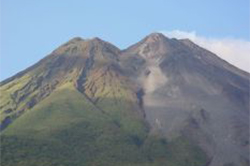
“Volcanoes throughout CR” © Sara Ford
Remember, you can always call us with the supplied cell phone (free of charge) to ask for directions! Don't feel shy, it happens to the best of us.
Safely reach your destinations with the least amount of worry and time-loss. Your electronic co-pilot will guide you comfortably through Costa Rica, so you can enjoy more time relaxing on your vacation.
We offer an optional WazePhone rental for $5 per day and it functions not only as a real-time GPS, but also a Wi-Fi hotspot, and of course...a mobile phone. Please request the WazePhone at the time of your reservation. This allows us to prepare your vehicle without delay.
You may drive using the drivers license issued by your home country.
Speed Limits:
• Highways
• Urban Areas
• Near Schools
& Hospitals
80 kph
50 mph
60 kph
24 mph
25 kph
15 mph
Please note: These are general speed-limits guidelines. The actual speed limit will be posted on signs.
Some other legal points to bear in mind are:
Emergency vehicles do not have the luxury of time to obey the same traffic laws that other drivers do. When their sirens AND flashing lights are on, emergency vehicles trump all others regarding right-of-way; one exception is a school bus with it's crossing guard sign displayed, but otherwise, green lights, yield signs, and roundabout politeness are set aside for any police vehicle, fire truck or ambulance.
When a siren approaches from behind:
When a siren approaches from the front:
When an emergency vehicle is stopped:
Following an emergency vehicle:
Driving over a fire hose:
Let's help the emergency responder to do their job by keeping them (and us) alive. Slow down, pull over when clear, and stay alert.
Fuel stations (called Bombas or Gasolineras) are widespread across Costa Rica. Regular, Super and Diesel fuel are readily available at all gas stations. Fuel prices are regulated by the government and thus are all exactly the same at every gas station — leaving you to enjoy your vacation without being on the look-out for the cheapest gas pump.
Service at gas stations is provided by attendants, or what they call in the U.S. as "full-service". There is no need to leave the car. Tipping is at your own discretion. On long trips, use fuel stops as an opportunity to relax and freshen-up.
Price of Regular Gas
September 23, 2019
Per Liter
Per U.S. Gallon
Price of Diesel Fuel
September 23, 2019
Per Liter
Per U.S. Gallon
Pull over if a police officer signals you to do so. Police officers may ask you to stop if there is an accident ahead, a checkpoint, or if you are violating the law for such things as not displaying a license plate or exceeding the speed limit.
Your personal documents, as well as the vehicle registration papers, are private property and may not be retained by police officers for any reason. If a police officer insists on stopping you or retaining your documents for no apparent reason, ask him to escort you to the nearest police station to clear the problem. If you believe a traffic police officer or any other law enforcement official acted inappropriately, or you have questions regarding their behavior, call 2257-7798, ext. 2506 and ask to be referred to the nearest police station.
If you are given a ticket, please pay it at the nearest state-owned bank and present a copy of the receipt to our staff when you return the rented vehicle. If you fail to do so, your credit card will be charged for the amount of the fine, plus a $15 administrative fee.
In the case of an accident, stay with the car and DO NOT MOVE IT, unless ordered by a police officer. Costa Rican law states that you must wait until the police and an insurance representative arrive at the scene. Contact Vamos immediately for further assistance. You may also report the accident by calling 911 or 800-800-8000.
There is a temptation to throw caution to the wind on vacation which is fine if this means trying a new food or ziplining. Driving in Costa Rica though should be approached with common sense!
Over the years, the Vamos Team has answered most of the typical questions/concerns that first-time visitors may have. To aid you, the reader, (and to protect your identity against asking silly questions on a travel forum), we’ll gathered more useful tips -- that haven’t been mentioned elsewhere on this website -- to help make your road trip successful:
Although it may seem daunting at first, annually there are tens of thousands of visitors to Costa Rica who enjoy the freedom to discover the country at their own pace with the help of their rental vehicle. After all, getting there is always half the fun of any vacation!
Don't forget to visit our Tico Tips outlining 7 insider tips from a local perspective.